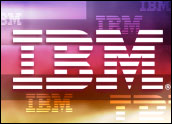
Benefiting from strong overseas sales and a weak U.S. dollar, IBM posted strong quarterly results and raised its guidance, adding to what’s becoming a winning streak for technology stocks.
On the heels of a strong report from fellow tech bellwether Intel, IBM beat expectations for its first quarter, with a 26 percent jump in profit.
Big Blue earned US$2.32 billion in the quarter that ended in March, compared with $1.84 billion a year ago. Revenue rose 11 percent to $24.5 billion, outpacing the $23.7 billion expected by analysts.
Comfort for Investors
The ability to execute in a “dynamic global economy” reflects the efforts to diversify IBM, with multiple revenue streams from software, hardware and services and reach into international markets, some of which continue to enjoy robust economic times, said CEO Sam Palmisano.
The fact that IBM has remained strong is comfort to tech investors who feared it was showing signs of being hit by a slowdown in spending from the financial services sector last fall. In fact, IBM Wednesday raised its profit target for the year, saying it now expects to earn $8.50 per share, up from an earlier forecast of $8.25.
“This is strong proof why we believe our business model is the right one for good times and for tough times,” said Chief Financial Officer Mark Loughridge. The economic turbulence has caused a shift, but not necessarily a reduction in IT spending. “Offerings that save cost and conserve capital have moved up the prioritization list of our clients.”
Breaking It Down
IBM shares flirted with new 52-week highs on the heels of the report, rising 2.6 percent in midday action Thursday to $123.45.
The company’s services business posted 17 percent growth — a more modest 9 percent expansion rate would have been reported had the dollar remained constant — to $14.6 billion.
In a sign that businesses are seeking to continue to outsource their IT departments, Big Blue’s strategic outsourcing business line saw 16 percent higher revenue, driven by a strong backlog and new business signings, Loughridge noted. “Despite economic concerns, we continue to sell into our existing accounts, where we can provide cost savings and a faster return on investment for our clients.”
The systems and technology unit, which sells mainframes and other high-end hardware, saw revenue decrease by 7 percent to $4.2 billion, caused in large part by weakness in low-end products. That softness had little impact on IBM’s bottom line because profit margins are smaller in those product lines.
IBM gained market share in the storage space where it competes with specialists such as EMC, with revenue from that unit rising 10 percent.
Software Sales
IBM’s software unit did what the company has been hoping it would — provide strong profit growth. Revenue from software sales rose 14 percent to $4.8 billion while income was up 22 percent. Middleware saw strong sales, as did products from its Tivoli, Cognos and Lotus brands, Loughridge noted.
Some software sales were slowed as the quarter came to a close, with more enterprises requiring additional sign-offs for purchases that may have delayed final buying decisions, he added.
IBM’s long-range plans call for software sales to become more important, combining with services to offer a steady annuity-like revenue stream and driving other parts of the business, UBS analyst Ben Reitzes told the E-Commerce Times.
“They’ve set some high targets for themselves,” he said. “The fact they can make progress amid talk of recession demonstrates how spread out their business is.”
IBM also purchased some businesses during its recent software acquisition spree in growing markets such as business intelligence and network management. “It bought a lot of firms that were on the growth track,” Reitzes noted.
World Party
IBM saw growth in all its geographical markets, with Americas revenue up 8 percent, Asia-Pacific sales rising 14 percent and Europe, Middle East and Africa up 16 percent.
That U.S. sales were not down significantly is a boost of confidence for the tech sector, which is being monitored closely for any sign that it’s going to sneeze due to the economy’s case of the flu, said Gartner analyst David Mitchell Smith.
The current round of technology acquisition and investment inherently differs from past booms in the software and hardware spaces, he told the E-Commerce Times.
“Businesses are continuing to buy technology they believe offers efficiency and cost savings, not because they’re overflowing with money to spend,” he commented.






















































Social Media
See all Social Media